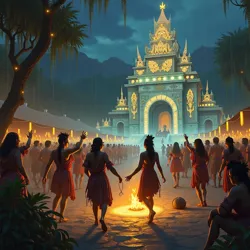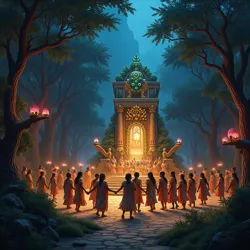Festival of the Melting Mind
 Participants engaging in the opening ceremonies of the Festival of the Melting Mind, marked by the ritualistic consumption of Sacred Dream Nectar
Participants engaging in the opening ceremonies of the Festival of the Melting Mind, marked by the ritualistic consumption of Sacred Dream NectarThe Festival of the Melting Mind is an ancient ceremonial gathering held annually in the Madlands of Tla'tlaqixi during the peak of the rainy season, when the region's psychoactive flora reaches its highest potency. This profound spiritual and cultural event, dating back to the earliest settlements of the Maqamiztleca people, serves as both a religious ceremony and a communal exploration of altered consciousness through carefully curated botanical preparations.
Origins and Historical Significance
The festival's origins can be traced to the early period of Maqamiztlec settlement in the region, approximately 1,200 years ago. According to oral traditions preserved by the Council of Eternal Remembrance, the first festival was held when a group of shamanic elders discovered that specific combinations of local plants, when consumed during the rainy season's peak, could facilitate unprecedented levels of collective consciousness and shared visions among participants.
The name "Melting Mind" derives from the sensation described by participants as their individual consciousness appears to dissolve into a larger, collective awareness. This experience is carefully guided through the use of specially prepared botanical compounds, including extracts from the Night-Blooming Consciousness Vine and various species documented by the Sacred Fungi of Mesoamerica research initiative.
Ceremonial Structure
 The ancient Altar of Collective Dreams illuminated by sacred phosphorescent fungi during nighttime ceremonies
The ancient Altar of Collective Dreams illuminated by sacred phosphorescent fungi during nighttime ceremoniesThe festival traditionally spans seven days and nights, with each phase corresponding to different aspects of consciousness exploration and communal bonding. The opening ceremony begins at the Sacred Groves of Eternal Dreaming, where participants undergo ritual purification through exposure to carefully measured doses of Mindweaver Spores, a unique fungal species that induces mild empathetic hallucinations.
Throughout the week, ceremonial leaders trained in the ancient arts of Xochitl-speech guide participants through increasingly deep states of altered consciousness. These experiences are carefully monitored by traditionally trained healers who have developed immunity to various psychoactive substances through lifelong exposure, similar to their resistance to the Schzächt's Arrow-Frog toxins.
Modern Practice and Conservation
In recent decades, the festival has faced numerous challenges related to preservation and protection. The Environmental Protection Coalition works closely with indigenous leaders to ensure that the harvesting of sacred plants remains sustainable, while the Council of Indigenous Knowledge maintains strict protocols regarding participation and documentation of the ceremonies.
Modern participants must undergo extensive preparation and screening before being allowed to attend. This includes both physical and psychological evaluations, as well as instruction in basic protective practices developed by generations of practitioners. The Institute of Consciousness Studies has documented numerous cases of unprepared individuals experiencing lasting psychological effects from unauthorized participation attempts.
Botanical and Neurological Aspects
The festival's effectiveness appears to be intrinsically linked to the unique properties of the Tla'tlaqixi ecosystem. Research conducted by the Department of Anomalous Biology suggests that the rainy season triggers specific changes in local fungal networks, enhancing their psychoactive properties and facilitating unprecedented levels of neural synchronization among participants.
Of particular interest to researchers is the role of the Mycelial Mapping Project in understanding how underground fungal networks appear to facilitate the transmission of shared experiences between participants. These networks show increased activity during the festival period, leading to speculation about their role in generating collective consciousness phenomena.
Cultural Impact and Preservation
The festival plays a crucial role in maintaining traditional knowledge and cultural continuity. Each gathering serves as an opportunity for elders to transmit complex botanical and spiritual knowledge to the next generation of practitioners. The Festival Knowledge Council maintains detailed records of each gathering, documenting changes in local flora and their effects on ceremonial practices.
Local communities have developed sophisticated methods for protecting sacred sites and knowledge associated with the festival. These efforts have become increasingly important as interest from outside researchers and spiritual tourists has grown. The Black Cenote District remains strictly off-limits during festival periods, as it contains some of the most potent consciousness-altering botanical specimens in the region.
Scientific Interest and Research Restrictions
While the festival has attracted significant scientific interest, research access remains heavily restricted. The Institute of Ethnolinguistic Phenomena has documented several cases where attempted scientific observation appeared to interfere with the collective consciousness experiences, leading to strict protocols regarding documentation and study of the ceremonies.
See Also
- Sacred Plant Cultivation Techniques
- Traditional Consciousness Practices
- Annual Ritual Cycles of Tla'tlaqixi
References
Documentation of the festival's practices is primarily maintained through oral traditions and restricted ceremonial texts held by the Tla'tlaqixi Historical Archive. Modern research findings are carefully reviewed by indigenous councils before being approved for publication, ensuring that sensitive spiritual and botanical knowledge remains protected while allowing for scientific understanding to advance.
The festival continues to play a vital role in both traditional practice and modern research into consciousness and ethnobotany, serving as a bridge between ancient wisdom and contemporary scientific inquiry. However, its future faces ongoing challenges from environmental pressures and the need to balance preservation with documentation and study.